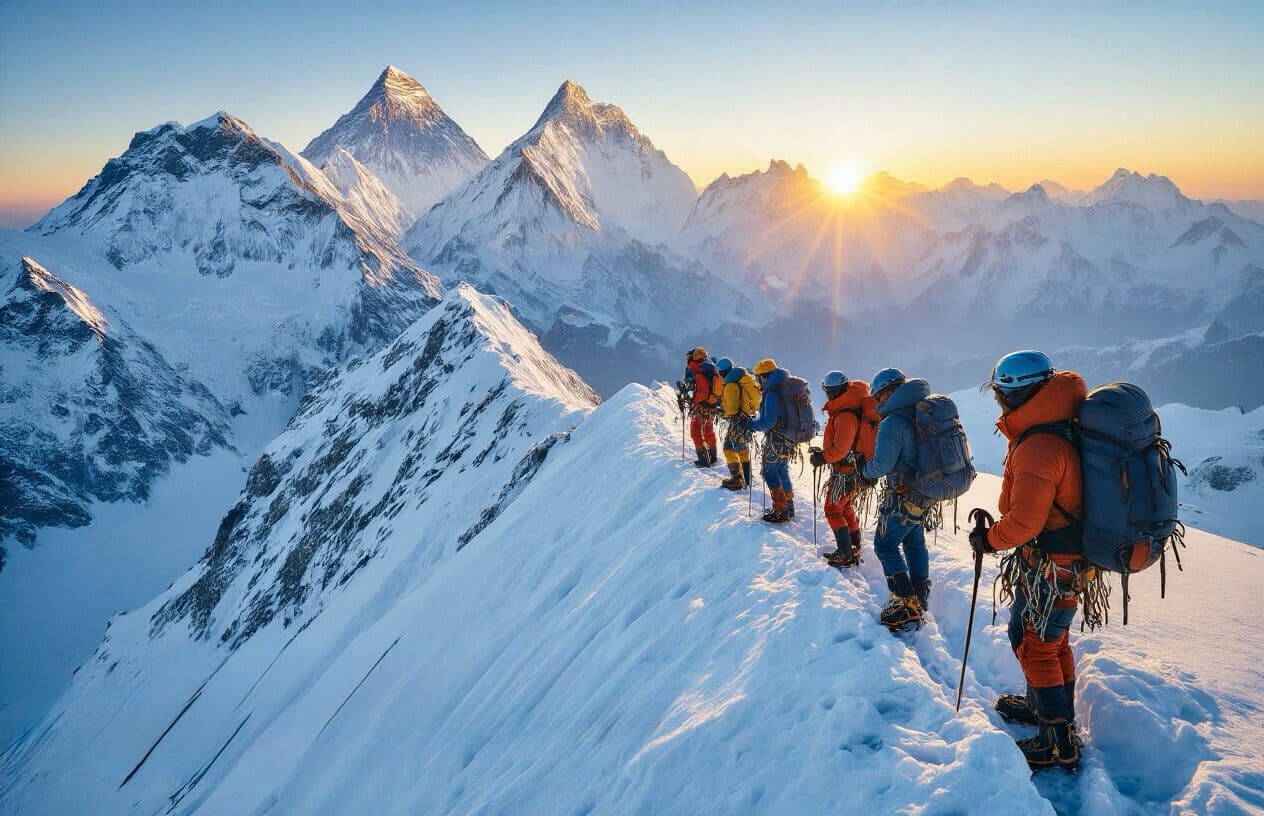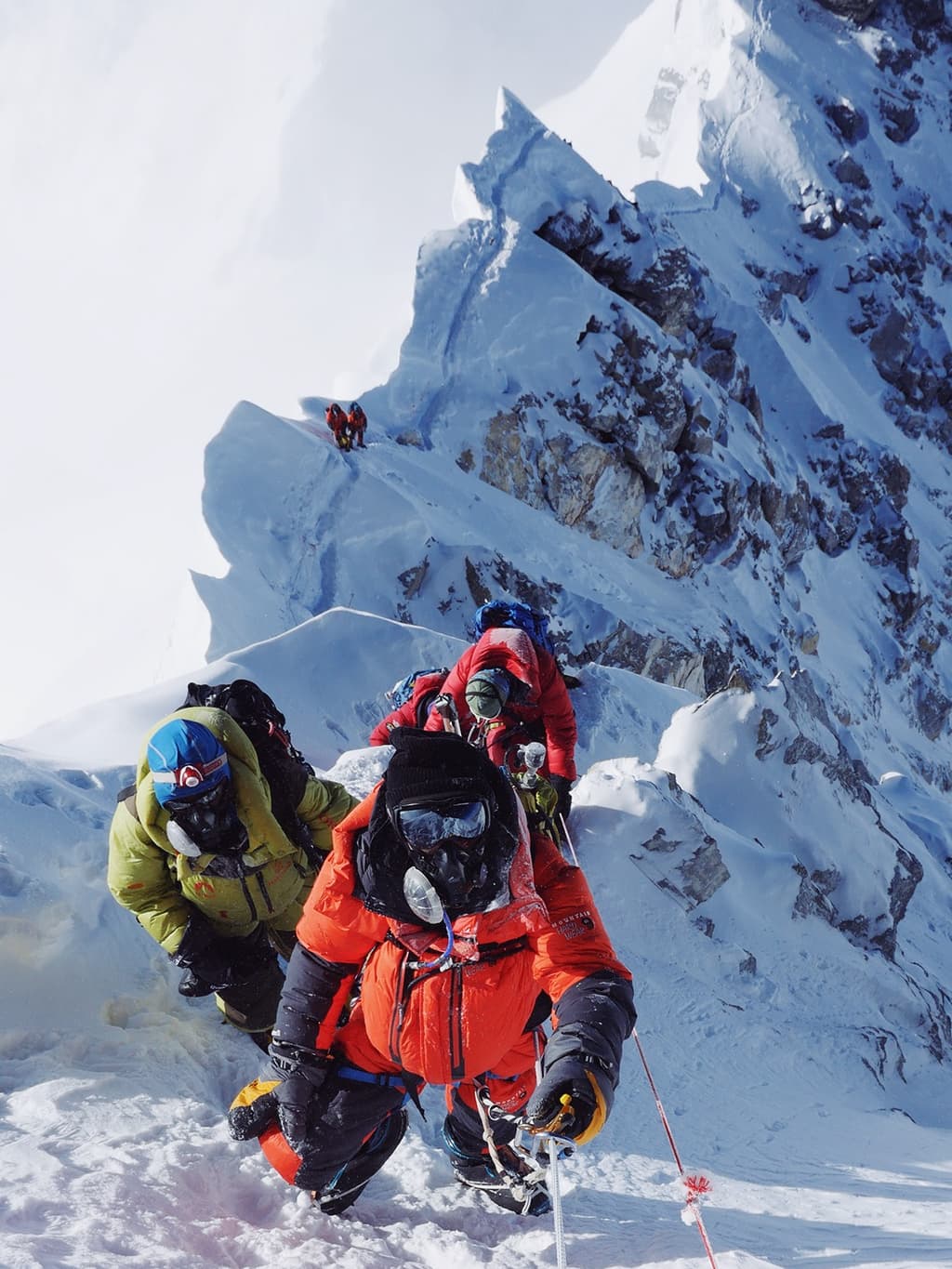Planning to conquer Island Peak (6,165m) in Nepal? This comprehensive packing guide from Everest Sherpa Expeditions will ensure you're properly equipped for this challenging high-altitude adventure. Perfect for mountaineers and trekkers looking to summit one of Nepal's most popular trekking peaks.
Your Island Peak journey requires specialized equipment to ensure your safety and comfort in extreme mountain conditions. We'll cover everything you need from technical climbing gear to proper layering systems that protect against the harsh Himalayan elements.
In this guide, you'll learn about:
- Must-have technical climbing equipment, including ice axes, crampons, and harnesses
- The ideal layering system for temperatures ranging from freezing summit conditions to warmer valleys
- Personal accessories and gear rental options that can save you both money and luggage space
With proper preparation and the right equipment, you'll be ready to tackle Island Peak's glaciers, snow slopes, and stunning summit ridge while enjoying the breathtaking views of Everest, Lhotse, and Makalu that await you.
Technical Climbing Equipment Requirements
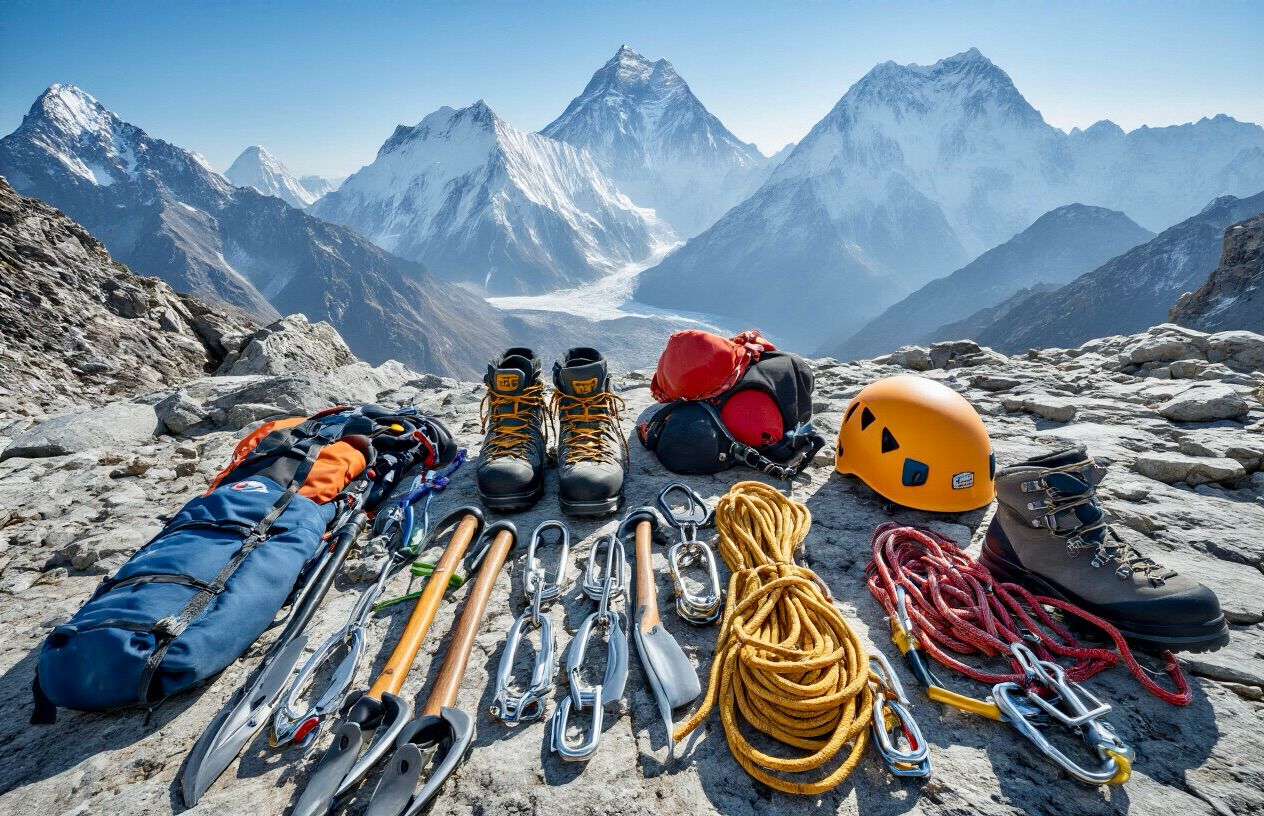
Island Peak (Imja Tse) at 6,189 meters requires specific technical climbing equipment to ensure safety and success during your expedition. Proper gear selection is critical for high-altitude climbing in the Himalayan conditions you'll encounter.
Ice Axe Selection and Sizing Guidelines
A general mountaineering ice axe (60-70cm) is essential for Island Peak. When selecting your ice axe, ensure it's the correct length—while standing, the spike should reach your ankle with your arm extended. Lightweight models with aluminum shafts and steel heads offer an optimal balance between durability and weight. Look for axes with ergonomic handles and leash systems designed for technical climbing sections.
Crampon Specifications and Compatibility
12-point steel crampons are recommended for Island Peak's mixed ice and rock terrain. Ensure your crampons are compatible with your mountaineering boots—step-in (automatic) crampons work best with rigid boots featuring welts at the toe and heel. Semi-automatic crampons are suitable for boots with heel welts only. Always check the crampon fit before your expedition and adjust properly to prevent dangerous slippage during critical climbing sections.
Harness Features for Cold Weather Conditions
Choose a mountaineering-specific harness with adjustable leg loops that can accommodate multiple layers of clothing. Look for models with padding for comfort during long belays and four gear loops for carrying carabiners and protection. Quick-release buckles are crucial for easy adjustment with gloves on. Your harness should be lightweight yet durable enough to withstand abrasion against rock and ice.
Carabiner Types and Safety Requirements
Bring a minimum of 4-5 locking carabiners (preferably screw-gate) and 2-3 non-locking carabiners. HMS/pear-shaped locking carabiners are versatile for belaying and rappelling. D-shaped carabiners offer higher strength ratings for critical protection points. Lightweight aluminum carabiners save weight in your pack while maintaining the necessary strength for mountaineering applications.
Belay Devices and Rope Management Tools
An ATC-guide or similar plate-style belay device with auto-block capability is ideal for Island Peak. This versatile device allows for belaying, rappelling, and managing rope during fixed-line sections. Include a Figure 8 descender as backup. Prusik cords (5mm accessory cord) should be carried for emergency self-rescue situations and can serve as backup systems during descents.
Ascender and Fixed Rope Equipment
A chest or handled ascender is critical for efficiently climbing the fixed ropes on Island Peak's headwall. Jumar-style ascenders work best when paired with a chest harness for stability. Include a 3-meter sling or daisy chain to connect your harness to the ascender. For added safety, carry a backup mechanical prusik (such as a Tibloc) that can be quickly deployed if your primary ascender fails during the climb.
Essential Safety and Navigation Gear

Safety equipment is paramount when tackling Island Peak, ensuring both protection and peace of mind during your expedition. Here's what you need to bring:
Helmet Protection Standards
A high-quality climbing helmet is non-negotiable for Island Peak. Look for models that meet UIAA (International Climbing and Mountaineering Federation) or CE EN 12492 certification standards. These helmets are specifically designed to protect against falling rocks and ice, which are common hazards on the route. Opt for a lightweight model (under 400g) with proper ventilation to maintain comfort during the climb, while ensuring it has a secure adjustment system that works with gloved hands.
Accessory Cord and Waist Leash Requirements
When navigating Island Peak's technical sections, you'll need:
- 2-3 meters of 6mm accessory cord for prusik loops and emergency repairs
- A dedicated ice axe leash to prevent losing this critical tool during steep sections
- A waist leash that connects to your harness, providing an extra layer of security for your equipment
- Pre-tied prusik loops for glacier travel and crevasse rescue scenarios
These items weigh little but can make a significant difference in emergencies.
Traction Devices for Variable Conditions
Island Peak presents various terrain challenges requiring different traction solutions:
- Crampons: 12-point steel crampons compatible with your mountaineering boots
- Microspikes: For lower sections with mixed terrain
- Anti-balling plates: Essential attachments for your crampons to prevent snow buildup
- Walking poles with snow baskets: For stability on approach hikes and snow slopes
Having the right traction for each section of the climb will significantly improve your safety and efficiency.
Emergency and First Aid Equipment
Prepare for unexpected situations with:
- Personal first aid kit containing blister treatment, pain relievers, altitude medication, and bandages
- Emergency shelter (bivi sack or lightweight tarp)
- Avalanche beacon, especially during the shoulder seasons
- Headlamp with extra batteries (minimum 200 lumens)
- Emergency communication device (satellite phone or personal locator beacon)
- Chemical hand warmers for emergencies
- Signal mirror and whistle for attracting attention if separated
With these safety and navigation essentials packed, you'll be well-prepared to handle the challenges of Island Peak while maintaining the highest safety standards throughout your expedition.
Layered Clothing System for High Altitude

Proper layering is crucial for survival and comfort during your Island Peak expedition. The extreme altitude conditions demand a strategic approach to clothing that provides flexibility, protection, and thermal regulation.
Base Layer Moisture Management
Your base layer serves as the foundation of your layering system, directly contacting your skin. Select moisture-wicking materials like merino wool or synthetic fabrics that transport sweat away from your body. For Island Peak, pack:
- 2-3 lightweight, long-sleeve base layer tops
- 2 thermal base layer bottoms
- 4-5 pairs of moisture-wicking underwear and sports bras
- 4-5 pairs of trekking socks plus 2-3 pairs of heavyweight mountaineering socks
Avoid cotton at all costs as it retains moisture and can cause dangerous cooling when wet.
Insulation Layers for Core Warmth
The mid-layers trap warm air close to your body, providing crucial insulation during cold conditions:
- 1-2 lightweight fleece jackets or pullovers
- 1 heavyweight fleece or softshell jacket
- 1 down or synthetic insulated jacket (minimum 700-fill power)
- 1 insulated pants for extreme cold conditions at high camp and summit day
These layers should be easily removable as your body temperature fluctuates during different activity levels and changing weather conditions.
Shell Protection from Wind and Weather
Your outer shell creates a barrier against precipitation and wind while allowing moisture to escape:
- 1 waterproof/breathable hardshell jacket with hood (Gore-Tex or equivalent)
- 1 pair of waterproof/breathable hardshell pants
- 1 down expedition parka for extreme cold (required for high camp and summit push)
Look for features like pit zips for ventilation, reinforced areas for durability, and compatibility with climbing harnesses.
Extremity Protection for Hands and Face
Your extremities are most vulnerable to frostbite and require special attention:
- Liner gloves for basic tasks and mild conditions
- Midweight insulated gloves for active climbing
- Heavyweight expedition mitts for summit day
- A balaclava or face mask that covers your entire face
- Neck gaiter or buff for neck protection
- Glacier sunglasses (100% UV protection and side shields)
- Ski goggles for wind protection during the summit push
- Warm hat that covers the ears
- Sun hat with brim for lower elevations
Remember that proper layering allows you to adjust your clothing system based on changing conditions, helping regulate body temperature and prevent both overheating and dangerous cooling.
Specialized Mountaineering Footwear

Mountaineering Boot Selection Criteria
Selecting the right mountaineering boots for your Island Peak expedition is crucial for both comfort and safety. For this challenging 6,189m peak, you'll need proper high-altitude mountaineering boots that provide adequate insulation and support. Look for double or triple-layer boots with removable liners that offer protection against extremely cold temperatures. The outer shell should be waterproof and durable, while the inner boot provides insulation and comfort.
When selecting your boots, consider the following criteria:
- Temperature rating (suitable for -20°C to -30°C conditions)
- Weight (lighter boots reduce fatigue)
- Ankle support for technical terrain
- Rigidity of the sole (necessary for crampon attachment)
- Proper sizing with room for thick socks and potential foot swelling at altitude
Crampon Compatibility and Fitting
Your mountaineering boots must be compatible with technical crampons for the steep ice and mixed terrain on Island Peak. Ensure your boots have rigid soles with welts at the toe and heel for secure crampon attachment. For Island Peak, 12-point crampons are generally recommended, with front points that can handle vertical ice sections.
Key considerations for crampon fitting:
- Verify crampon compatibility with your specific boot model
- Properly adjust crampons to fit securely without movement
- Test the fit before your expedition in similar conditions
- Consider step-in (automatic) crampons for the most secure attachment
- Bring a small repair kit for field adjustments if needed
Gaiters and Snow Protection
Full-length waterproof gaiters are essential for keeping snow out of your boots during the ascent. They also provide additional wind protection and help keep your lower legs dry when traversing snow fields or during unexpected weather changes.
When selecting gaiters:
- Choose durable, waterproof materials with reinforced lower sections
- Ensure they're tall enough to cover your entire boot and lower leg
- Look for models with secure underfoot straps that won't break in extreme conditions
- Consider breathability to reduce moisture buildup
- Test the closure system with gloves on to ensure ease of use in cold conditions
Sock Layering System
Proper sock layering is vital for foot comfort and preventing blisters and frostbite. A three-layer system is recommended for high-altitude expeditions like Island Peak:
- Inner liner socks: Thin, moisture-wicking synthetic or silk socks that prevent friction
- Mid-layer socks: Medium-weight insulating socks, preferably made of wool or wool blend
- Outer expedition socks: Thick, insulating socks designed for extreme cold
Always pack multiple pairs of each layer to ensure you have dry socks throughout your expedition. Even with waterproof boots, feet will perspire during the climb, and having fresh, dry socks can prevent many foot-related issues that could compromise your summit attempt.
Remember that your sock system should be tested with your boots before the expedition to ensure proper fit without constriction that could reduce circulation and increase frostbite risk.
Personal Gear and Accessories
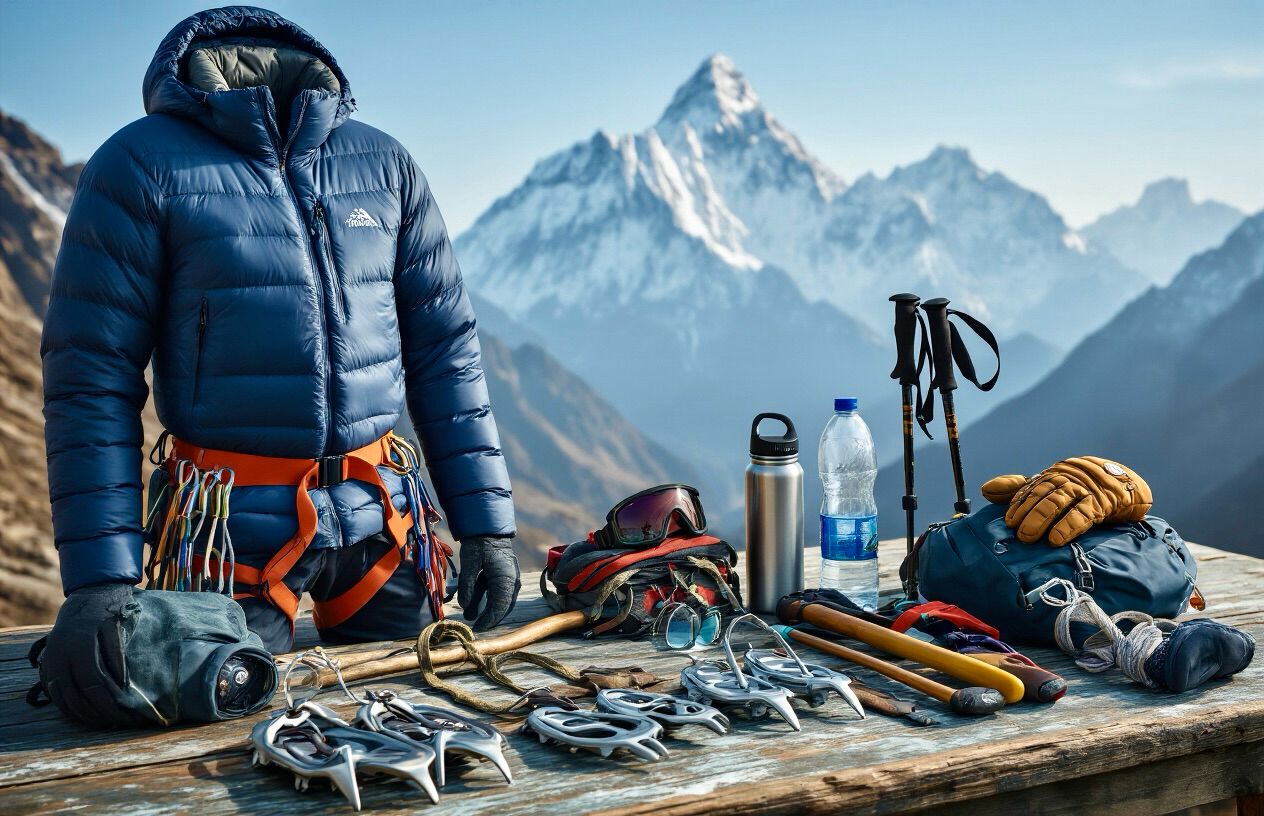
Backpack and Carrying Solutions
For your Island Peak expedition, you'll need both a larger expedition backpack and a smaller daypack. The main backpack should be 60-80 liters with adjustable suspension, multiple compartments, and weatherproof features. Look for models with ice axe attachments and gear loops specifically designed for mountaineering. Your daypack (30-40 liters) will be used during acclimatization hikes and on summit day, carrying essential items while your larger gear remains at base camp.
Consider using waterproof stuff sacks and compression bags to organize your gear within your pack. This not only protects your equipment from moisture but also maximizes limited space.
Sleeping System for Sub-Zero Temperatures
A quality sleeping system is critical for recovery at high altitude. Your sleeping bag should be rated for at least -20°C (-4°F), with a comfort rating that accounts for the extreme conditions on Island Peak. Down-filled bags offer a superior warmth-to-weight ratio but require careful protection from moisture. Always use a waterproof stuff sack.
Complement your sleeping bag with a good insulating pad – preferably a combination of a closed-cell foam pad (R-value 2-3) beneath an inflatable pad (R-value 4-5) for maximum insulation from the frozen ground. This dual-layer approach provides backup insulation if one pad fails.
Hydration and Nutrition Equipment
Staying hydrated at altitude is crucial for performance and preventing altitude sickness. Bring 2-3 wide-mouth water bottles (1 liter each) that can handle boiling water and won't freeze easily. Insulated bottle covers help prevent freezing. A thermos for hot drinks is invaluable on cold mornings and summit day.
For nutrition, pack a dedicated mess kit including a bowl, insulated mug, and spork. Consider bringing electrolyte tablets, energy gels, and protein bars that won't freeze at high altitude. Store snacks in accessible pockets for easy consumption during climbs.
Sun Protection at High Altitude
UV radiation increases approximately 4-5% with every 1,000 feet of elevation, making sun protection essential on Island Peak. Pack high SPF sunscreen (50+) that's water and sweat-resistant, and reapply frequently. Include SPF lip balm to prevent painful cracking.
Quality sunglasses with side shields offering 100% UV protection and glacier glasses for summit day are non-negotiable. Consider a backup pair in case of loss or damage. A wide-brimmed hat and buff/neck gaiter provide additional protection for exposed skin.
Lighting and Navigation Tools
A reliable headlamp with extra batteries is essential for pre-dawn summit pushes and navigating camp in darkness. Look for models with at least 250-300 lumens and a red-light mode to preserve night vision. Pack backup batteries stored in waterproof containers and kept warm in inner pockets.
For navigation, bring a compass and a physical map of the Island Peak region as backups to GPS devices. A lightweight GPS device with pre-loaded routes and waypoints adds an extra safety layer. Consider an altimeter watch to monitor elevation gain and descent rates, which helps with acclimatization tracking.
Equipment Rental and Cost Considerations

Available Rental Gear in Chhukung
For climbers who prefer not to purchase all the specialized equipment needed for Island Peak, Chhukung offers convenient rental options. This small settlement, positioned near the base of Island Peak, serves as the last stop before heading to base camp and provides access to essential climbing gear. Here you'll find rental shops offering technical equipment, including:
- Ice axes and crampons
- Climbing harnesses and helmets
- Jumar ascenders and figure-8 descenders
- High-altitude boots
- Down suits and expedition-grade jackets
Many climbers choose to rent these items rather than investing in expensive equipment they may use only once. The rental shops in Chhukung are experienced in outfitting climbers specifically for Island Peak conditions.
Complete Equipment Package Pricing
Rental pricing for Island Peak equipment packages typically follows a tiered structure:
|
Package Type |
Included Items |
Approximate Cost (USD) |
|
Basic Package |
Harness, carabiners, prussik cords |
$50-75 |
|
Standard Package |
Basic package + crampons, ice axe, helmet |
$120-180 |
|
Complete Package |
Standard package + down suit, boots, sleeping bag |
$250-350 |
Prices vary based on equipment quality, rental duration, and seasonal demand. Most operators offer discounts for longer rental periods, which is advantageous for those acclimatizing properly before their summit attempt.
Quality Standards for Rental Equipment
When renting equipment for a technical climb like Island Peak, quality and safety standards are paramount. Reputable rental providers in Chhukung maintain their gear according to international mountaineering standards. Before accepting any rental equipment, climbers should:
- Inspect all items for visible damage or excessive wear
- Test all mechanical components (ascenders, descenders, carabiners)
- Ensure crampons are properly sharpened and fit your boots correctly
- Verify that all safety equipment has appropriate certification marks
Everest Sherpa Expeditions recommends working with established rental providers who regularly maintain and update their inventory. The safety implications of using substandard equipment at 6,189 meters cannot be overstated, making it worth paying slightly more for guaranteed quality and reliability.
Expedition Services and Inclusions
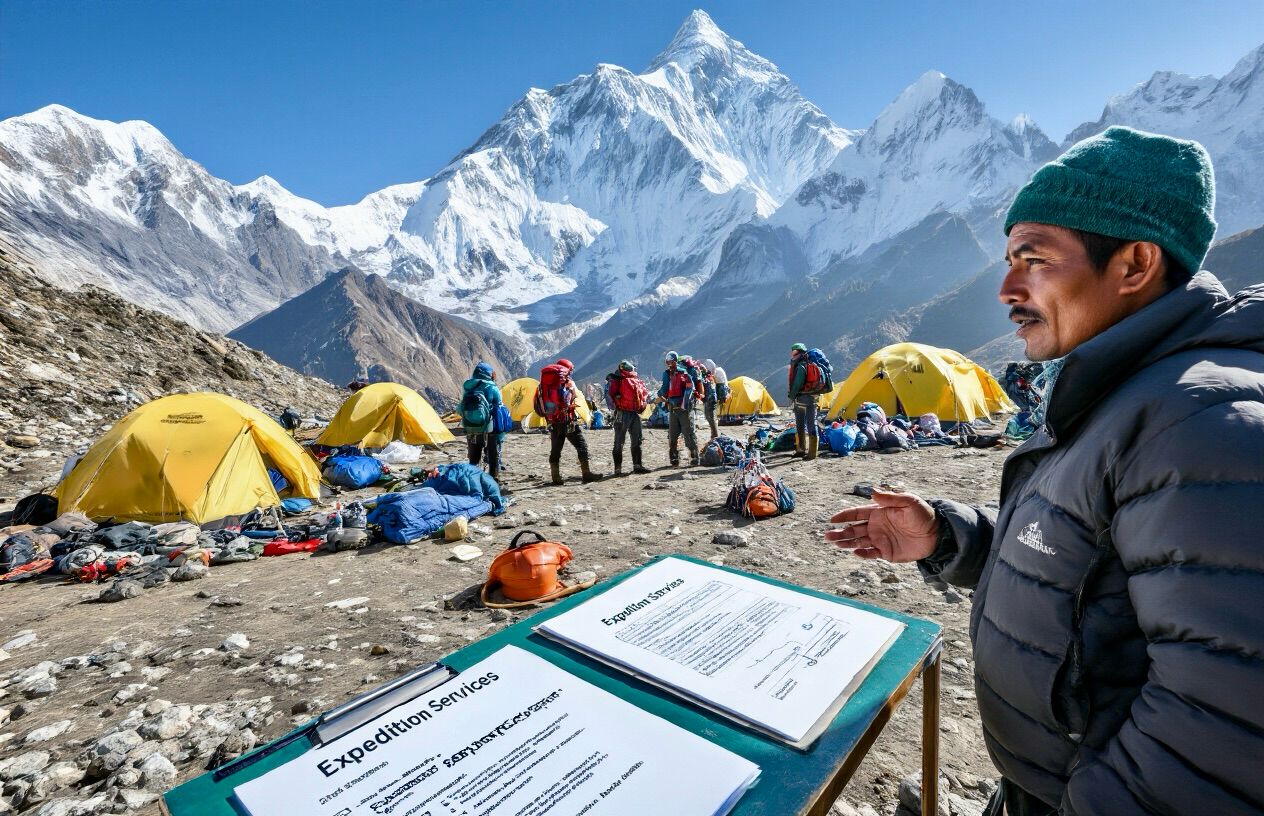
Professional Guide and Sherpa Support
At Everest Sherpa Expeditions, we provide comprehensive support for your Island Peak expedition with experienced guides and Sherpas who are intimately familiar with the terrain. Our expedition teams include certified climbing guides with extensive high-altitude experience and local Sherpas who offer invaluable cultural insights and technical assistance. The typical guide-to-climber ratio is 1:4 for general trekking portions and 1:2 for technical climbing sections, ensuring personalized attention and maximum safety throughout your journey.
Accommodation and Meal Arrangements
Your expedition package includes a variety of accommodation options tailored to each stage of the journey. In Kathmandu, you'll stay in comfortable 3-star hotels before and after the expedition. During the trek, we provide teahouse lodging in the Khumbu region with basic but comfortable rooms. At Island Peak Base Camp, you'll experience expedition-style camping with high-quality tents designed for mountain conditions. All meals are included throughout the expedition, featuring nutritious Nepali and international cuisine prepared by our experienced mountain chefs, with special attention to dietary requirements and high-altitude nutrition needs.
Permits and Documentation Requirements
We handle all necessary paperwork for your expedition, including the Island Peak climbing permit (approximately $250), Sagarmatha National Park entry fee ($30), Khumbu Pasang Lhamu Rural Municipality fee ($20), and TIMS card (Trekkers' Information Management System). Our team manages all documentation processes, ensuring compliance with local regulations and removing administrative burden from climbers. We also assist with travel insurance verification, ensuring your policy includes adequate coverage for high-altitude mountain climbing and helicopter evacuation.
Transportation and Helicopter Services
Your expedition includes all ground transportation in Nepal, from airport transfers in Kathmandu to domestic flights between Kathmandu and Lukla. We organize porters and yaks for equipment transport during the trek, allowing you to hike with only a day pack. In case of emergencies, we maintain partnerships with reliable helicopter services for swift evacuations from remote locations, with coordination handled by our operations team in Kathmandu.
Safety Monitoring and Medical Support
Safety is our paramount concern on Island Peak expeditions. We equip teams with satellite phones and emergency communication devices for constant contact with our Kathmandu office. Guides carry comprehensive first aid kits and are trained in wilderness medicine and high-altitude emergency protocols. We conduct regular health checks, including pulse oximetry, to monitor oxygen saturation levels and early detection of altitude-related issues. Our teams also access weather forecasting services for informed decision-making regarding summit attempts and route changes.
Pre-Climb Preparation and Training

Physical Fitness Requirements
Preparing for Island Peak requires dedicated physical conditioning. Climbers should focus on cardiovascular endurance through regular activities like hiking, running, swimming, or cycling at least 4-5 times per week for 30-60 minutes. Strength training for legs, core, and upper body is essential, with particular attention to leg muscles that will carry you uphill for hours. Incorporate climbing-specific workouts such as stair climbing, hill repeats, and weighted pack training.
Begin your fitness regimen at least 3-6 months before your expedition. A good benchmark is the ability to hike 6-8 hours with a 15kg pack comfortably. Remember that Island Peak reaches 6,189m (20,305ft), demanding excellent stamina and recovery capacity at altitude.
Technical Skill Prerequisites
While Island Peak is considered a "trekking peak," it requires basic mountaineering skills. Climbers should be proficient in:
- Using crampons and ice axe for glacier travel
- Rope management for fixed lines and team rope travel
- Understanding basic climbing commands and protocols
- Jumar/ascender use for the steep headwall section
- Self-arrest techniques for fall prevention
- Basic knot tying and harness adjustment
Previous experience on snow and ice is strongly recommended. Consider taking a basic mountaineering course if you're new to technical climbing.
Acclimatization Strategy and Timeline
A proper acclimatization strategy is critical for safety and summit success. The Everest Sherpa Expeditions itinerary includes:
- Gradual ascent through the Khumbu Valley over 7-10 days
- Strategic rest days at key elevations (Namche Bazaar, Dingboche)
- Acclimatization hikes to higher elevations followed by sleeping lower
- Minimum 2-3 nights at Island Peak Base Camp (5,087m) before summit attempt
- The hydration target of 4-5 liters daily during the acclimatization phase
Understand altitude illness symptoms and communicate any issues to your guide immediately. Your body needs time to adapt to decreasing oxygen levels—rushing this process endangers your health and summit chances.
Equipment Familiarity and Practice
Before departure, become thoroughly familiar with all technical equipment:
- Practice wearing and walking in mountaineering boots
- Test layering systems in various conditions
- Ensure your harness fits properly and you can put it on quickly
- Practice with crampons on different terrain if possible
- Learn to efficiently pack and unpack your expedition backpack
- Test headlamps, cameras, and other electronic gear
Conduct several practice hikes with your fully loaded backpack to identify any comfort issues. At high camp, your guide will conduct a final equipment check and provide refresher training on fixed-line techniques before summit day.
Summit Day Logistics and Procedures
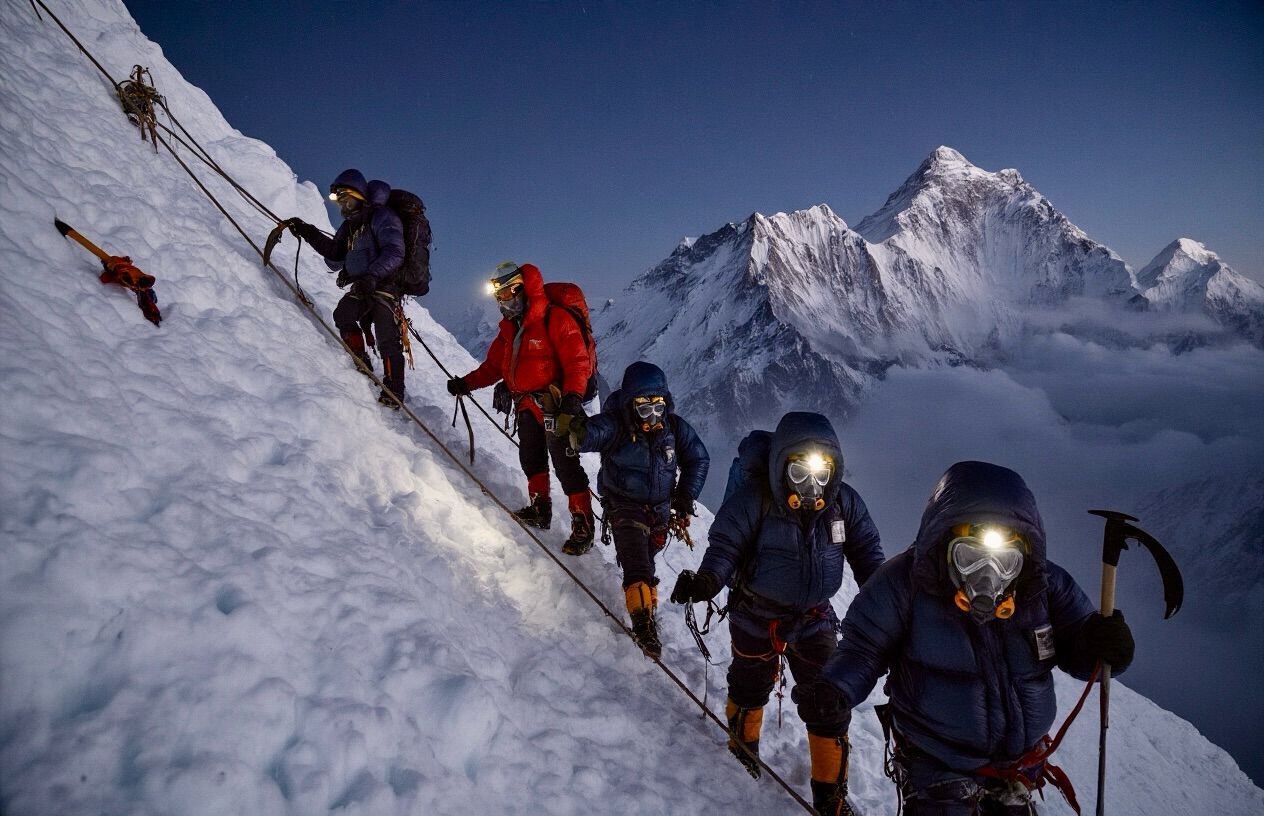
Early Morning Departure Protocol
Summit day on Island Peak begins with a very early alpine start, typically around 1-2 AM. This strategic timing allows climbers to reach the summit before afternoon weather conditions deteriorate. The pre-departure briefing occurs the evening before, where guides review the route, weather forecasts, and safety procedures.
Before departure, climbers should:
- Consume a light but energy-rich breakfast
- Double-check all technical equipment (harness, crampons, ice axe)
- Ensure headlamps have fresh batteries
- Pack summit snacks and at least 2 liters of water (preferably in insulated containers)
- Apply sunscreen preemptively for the morning sun
Route Navigation and Technical Sections
The climb from high camp involves navigating through several distinct sections:
- Initial rocky terrain - Requires careful footing with headlamps
- Snow and ice fields - Where crampons become essential
- The headwall - A 100-meter near-vertical ice wall requiring fixed rope techniques
- The ridge traverse - A narrow, exposed section leading to the summit
The most technically challenging section is the headwall, where climbers must use jumaring techniques on fixed ropes. Guides from Everest Sherpa Expeditions will position themselves strategically along difficult sections to assist.
Weather Window Optimization
Summit attempts are highly dependent on favorable weather conditions. The expedition team monitors:
- Wind speeds (ideally below 30 km/h)
- Precipitation forecasts
- Temperature trends
- Cloud cover patterns
The head guide makes the final decision on whether to proceed with the summit push based on these factors. Flexibility in the itinerary allows for potential delays of 1-2 days if needed to optimize the weather window. Clear communication about weather decisions is maintained throughout the expedition.
Descent and Safety Procedures
After summit celebrations, the descent requires equal attention to safety:
- Climbers rappel down the headwall using established anchors
- Teams maintain rope connections through crevassed areas
- Regular hydration and energy intake is essential
- Guides monitor each climber for signs of fatigue or altitude issues
Emergency protocols include:
- Radio communication with base camp
- Designated rest points with emergency gear caches
- Pre-positioned oxygen supplies for medical emergencies
- Established evacuation routes for various scenarios
The entire summit day typically takes 8-12 hours round trip, with climbers returning to high camp by early afternoon to rest before descending to base camp the following day.
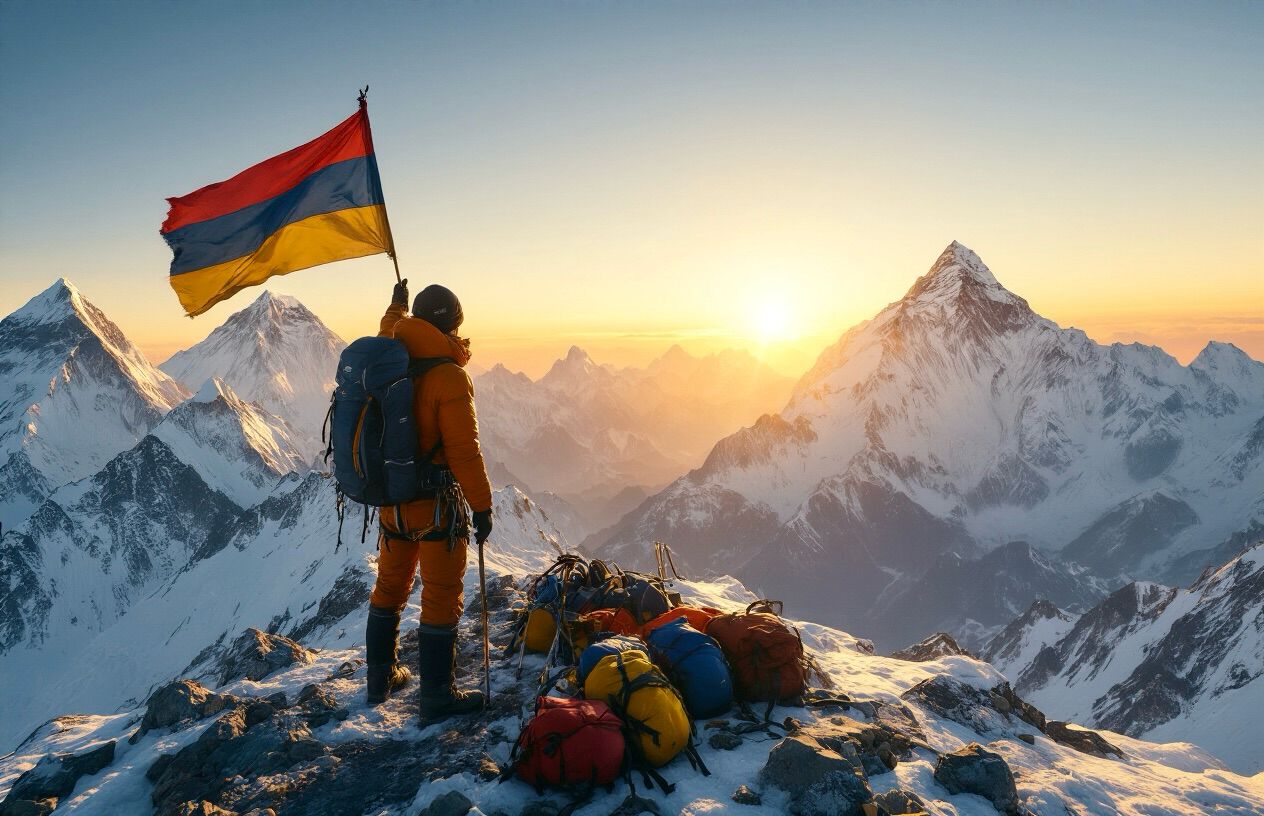
Conclusion
Preparing for Island Peak requires careful planning and the right equipment. From technical climbing gear like ice axes and crampons to proper layered clothing and specialized footwear, each item plays a crucial role in your safety and comfort during the expedition. Whether you choose to bring your own equipment or utilize rental options in Chhukung, ensuring you have the proper tools for the 6,165m summit is essential.
Remember that Island Peak climbing is not just about gear, but also about preparation, training, and acclimatization. The journey through the Everest region offers breathtaking views and cultural experiences that enhance your expedition. With proper equipment, adequate training, and the support of experienced guides from Everest Sherpa Expeditions, you'll be well-positioned to accomplish this challenging yet rewarding Himalayan adventure. Your success on Island Peak begins with what you pack—choose wisely and climb safely.
If you need any further information, please contact us by email: [email protected], Phone: +977- 980 195 6248 (WhatsApp).
